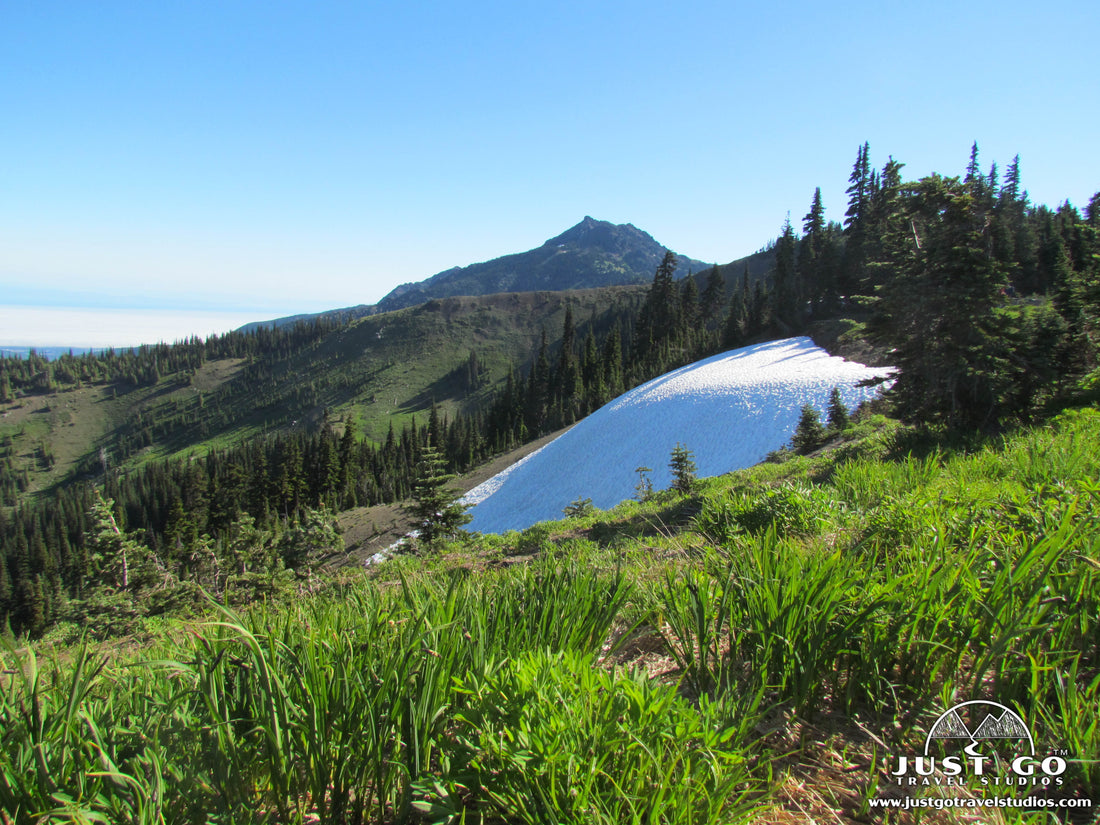While just seeing Washington State and the Olympic Peninsula by car is an adventure in itself, there is nothing quite like actually getting out and hiking in Olympic National Park. With its nine distinct areas of the park, you can literally hike here for weeks on end and still have hikes that you haven’t done yet. From the mountains of Hurricane Ridge to the Hoh and Quinault Rain Forests to Moro and Rialto Beaches, the diversity of the scenery will leave you speechless.
The problem is, since none of us have unlimited time to hike in Olympic National Park, how do you pick the best hikes to spend your time when visiting? It’s not easy, but we hope that this guide helps out. The truth is, you really can’t go wrong with any hike in Olympic National Park. However, we’ll do our best to help you figure out what is right for you and your hiking companions!
WHAT OLYMPIC NATIONAL PARK HIKE IS RIGHT FOR ME?
There are really all sorts of hikes in Olympic National Park. If you want to hike for 30 minutes or for several days, there is a hike for you! To help things out, we’ve created our unique charts that can help you find a hike that has the right distance and elevation gain. Our “sweet spot” is usually 4-7 miles, and less than 2,000 feet of elevation gain. But you are different for sure, and hopefully this helps!
For easy hikes or if you are limited on time, this chart is a great place to start.

For those of you who are seeking a bit more of a challenging hike but not too strenuous, this chart will help you out.

Finally, if you want a challenging / strenuous hike, then this chart will help narrow down a few options to consider.

We don’t feature all of these hikes in this blog, but you can find out more in our itinerary.
Our Olympic National Park Itinerary is a great way to help you plan your trip to the park. We include what to pack, where to stay, what hikes you may want to consider, useful maps, what to do in the area and much more!
HURRICANE HILL TRAIL

Hurricane Hill Trail map, courtesy of the National Park Service
If you want a great family-friendly hike that does involve a bit of elevation gain but has a wonderful payoff, then the Hurricane Hill Trail is for you! This 3.2-mile (round-trip) trail will take about 2 hours to complete and climbs approximately 740 feet total.
After leaving the parking area and heading north, the trail heads along a ridge before meeting the junction of the Little River Trail. The first part of the trail is actually wheelchair accessible. Continue heading to the northwest, which is where this hike starts to climb. The climb continues for the remaining 1.1 miles as you approach the peak.
At the peak you’ll have a panoramic view of the Olympics and Puget Sound. There are great views along the entire way, though!
The trailhead is located 1.5 miles past the Hurricane Ridge Visitor Center at the top of Hurricane Ridge.

Hurricane Hill Trail, courtesy of Josve05a
CIRQUE RIM AND BIG MEADOW TRAIL

Cirque Rim and Big Meadow Nature Trail map, courtesy of the National Park Service
While you are up on Hurricane Ridge, the Cirque Rim and Big Meadow Trail is certainly worth checking out, and it won’t take too long at all. This 0.4-to-0.8-mile loop (depending on the route that you take) has minimal elevation gain and a chance to see wildlife!
The short hike travels through the woods near a meadow with overlooks to Port Angeles, WA. You can also see into Canada! If you arrive early in the morning or toward dusk, you have the best chance of seeing wildlife. The trail is also fully wheelchair accessible.
Expect to spend about 30-45 minutes on this trail, depending on how fast you hike and how often you stop to take pictures!
The trailhead for the Cirque Rim and Big Meadow Trail starts from the parking area at Hurricane Ridge.
Hike option: just do the outer loop for a shorter, 0.4-mile hike.

HIGH RIDGE TRAIL TO SUNRISE VIEWPOINT

Hurricane Hill Trail map, courtesy of the National Park Service
Though a relatively short trail (1.2-mile round-trip), this quick hike climbs just under 300 feet on its way up to the Sunrise Viewpoint. It leaves right from the visitor center parking area on Hurricane Ridge and heads northeast.
If you take this trail in the early summer, expect to see a bit of snow on the trail, so be prepared to turn back if it gets to slippery.
At the top, you’ll have great views of the Strait of Juan de Fuca.
The trailhead begins from the east end of the parking area at the top of Hurricane Ridge.
SUNRISE TRAIL TO MOUNT ANGELES

Sunrise Trail to Mount Angeles map, courtesy of the National Park Service
For a challenging (but very rewarding hike), the hike on the Sunrise Trail and High Ridge Nature Trail to Mount Angeles may be for you! The hikes starts off relatively easy for the first 2 miles as you head along a ridge (which has great views itself!).
At the 2.0-mile point where the trail splits off to the north, the incline gets steep-I mean, really steep. In fact, nearly all of the 2000 feet of elevation gain happens in the period of a half-mile. This part of the trail takes a bit of time, and you will be going slowly.
At the top you’ll be rewarded with a phenomenal view (on a great weather day, that is!). You’ll be over a mile-high, at an elevation of 6,454 feet.
The trailhead starts from the parking area at Hurricane Ridge.

Mount Angeles Trail, courtesy of DVS
MARYMERE FALLS TRAIL

Marymere Falls Trail map, courtesy of the National Park Service
Olympic National Park is full of hikes that are relatively easy with a good reward, and the hike to Marymere Falls is one of them! Starting in the Lake Crescent area (at the ranger station), the trail is only 1.8-miles (round-trip) long and will take just about an hour, plus time at the falls.
The hike heads to the south from the Storm King Ranger Station after crossing underneath Highway 101. There is a slight incline for the first 0.8-miles, and then the trail goes up stairs as you approach the falls (which is not required to see the falls, but certainly a nice part of the hike to get you up and close!). The total elevation gain is nearly 300 feet.
Marymere Falls is about 90 feet high and is situated in the middle of a beautiful old-growth forest.
The trailhead for the Marymere Falls Tail starts at the end of Lake Crescent Road.

Marymere Falls, courtesy of Sea Cow
MOUNT STORM KING TRAIL

Mount Storm King Trail map, courtesy of the National Park Service
Many consider Mount Storm King to be the best hike in Olympic National Park. However, it’s not for everyone s it does have a bit of climbing! This 5.3-mile (round-trip) hike starts by sharing the same trail as the hike to Marymere Falls. After about 0.5-miles, the trail breaks off to the east to head to the peak. The climbing begins here, increasing steadily on the way to the peak.
As you take on the incline, you’ll pass through a green moss forest. You’ll have an amazing view of Lake Crescent before you make the final push to the top of the mountain. The final climb involves hanging on to a rope to help you get up to the top. Even if you stop at the viewpoint of Lake Crescent, this hike is totally worth it!
The total elevation gain is just over 2000 feet, and you can expect it to take about 4 hours. Bring gloves for the rope section!
The trailhead is located at the end of Lake Crescent Road.

Mount Storm King from Lake Crescent, courtesy of Elwhajeff
PYRAMID MOUNTAIN TRAIL

Pyramid Mountain Trail map, courtesy of the National Park Service
Another challenging but rewarding hike is the trail up Pyramid Mountain. This 6.6-mile (round-trip) trail climbs a total of 2500 feet.
After departing the trailhead, the trail starts to climb immediately, and gets steeper along the entire hike. However, along the way you’ll have good views of Lake Crescent, before you get an absolutely spectacular view at the top.
Along the way you’ll have switchbacks to help you up to the top. Be advised that there is a part where you have to cross a landslide, and that is a bit sketchy so you’ll have to be careful.
The trailhead is located on Damp David Junior Road, about 3.1 miles from the intersection of Highway 101 on the north side of Lake Crescent.

Pyramid Mountain view of Lake Crescent, courtesy of Elwhajeff
SOL DUC FALLS NATURE TRAIL

Sol Duc Falls Trail map, courtesy of the National Park Service
A relatively quick and easy hike, the 1.7-mile (round-trip) trail to Sol Duc Falls is an excellent choice. There is only about a 300 feet elevation gain as you are immersed in the forest along the Sol Duc River.
At the end of this trail is Sol Duc Falls, where there is a bridge with incredible views of these small (15 feet) but really pretty falls. This is a great spot to take a bunch of pictures and practice your waterfall photography! Our kids loved this trail in particular.
The trailhead is located at the Sol Duc Trailhead at the end of Sol Duc Road.
Hike option: If you want to extend the trail further, head back on the Lovers Lane Trail which travels on the south side of Sol Duc River. This does extend the hike to 5.5 miles total.
SECOND BEACH TRAIL

Second Beach Trail map, courtesy of the National Park Service
The hike to Second Beach is one of the more popular trails in the park. It’s on the west coast, and the great thing about this hike is that you end up at a beach at the end of the hike! This easy, 1.4-mile (round-trip) hike heads to the south through the woods.
The great thing about this beach is that during low-tide, you can go exploring for wildlife and interesting shells. The beach is great, and you can spend hours here. There also isn’t much in the way of elevation gain as well, though it’s about 80 feet and occurs as you approach the beach.
The trailhead starts from La Push Road, about 4.5 miles after the fork that leads to Rialto Beach.

HALL OF MOSSES TRAIL

Hall of Mosses Trail map, courtesy of the National Park Service
The Hall of Mosses Trail is a crowded one for sure, but for a good reason. This 1.0-mile (round-trip) loop hike is really easy, great for nearly all ages and has great scenery.
The trail starts from the Hoh Rain Forest Visitor Center and heads north. It passes through the dense forest and really highlights the massive amount of moss in the area.
The trailhead starts at the Hoh Rain Forest Visitor Center.

Hall of Mosses Trail, courtesy of the National Park Service
SPRUCE NATURE TRAIL

Spruce Nature Trail map, courtesy of the National Park Service
This is another easy trail, and less crowded than the Hall of Mosses Trail. The Spruce Nature Trail is about 1.4-miles (round-trip) and is a loop. It heads along the Hoh River, which originates at Mount Olympus and travels 50 miles to the Pacific Ocean.
You can expect some mud on this hike, but it’s easy, and has minimal elevation gain.
We covered this hike in detail in our blog, Hiking the Spruce Nature Trail in Olympic National Park.
The trailhead starts on the south side of the Hoh Rain Forest Visitor Center.

SAND POINT TRAIL

Sand Point Trail map, courtesy of the National Park Service
In the remote northwestern portion of the park of Ozette, there are a few cool trails that are worth checking out. The Sand Point trail is one of those. This mostly flat trail is moderate in difficulty (only due to the length of 5.5-miles (round-trip) and the trail is mostly flat, with only a 200 feet gain in elevation over the entire trail.
The hike starts off by heading to the southwest and continues pretty straight over the entire hike. Part of it is on a boardwalk through the forest. At the end of the trail is Sand Point, which is beautiful!
The trailhead to the Sand Point Trail begins at the Ozette Ranger Station, which is reached by driving nearly 2 hours from Port Angeles on Highway 112. It’s a haul to get out here, but you won’t see many people!

Sand Point, courtesy of Jason Pratt
STAIRCASE RAPIDS TRAIL

Staircase Rapids Trail map, courtesy of the National Park Service
In the far southeastern side of the park in the Staircase Area is one of the best family trails in the park, the hike to Staircase Rapids. At a distance of 2.1-miles (round-trip), this hike will take about an hour and the entire family will enjoy it!
There is an elevation gain of about 200 feet across the entire hike. The trail goes through an old growth forest that includes a log bridge and some fantastic views! Take the Staircase Rapids Nature Trail out before returning on the North Fork Skokomish River Trail after you cross the Skokomish River.
Only part of this loop is open due to recent mudslides (as of early 2018), so check with the ranger for information on the status of the hike. This trail is great for families, which is why the hike is ranked so high and is so popular.
The trailhead starts at the Staircase Ranger Station on Lake Cushman. It’s about 2 hours from Port Angeles, or 1 hour from Olympia, WA.
KESTNER HOMESTEAD TRAIL

Kestner Homestead Trail map, courtesy of the National Park Service
Located in the Quinault Rain Forest, the Kestner Homestead Trail is another great family hike. This 1.4-mile (round-trip) hike is a loop that travels through a forest of maple, hemlock and spruce. Halfway through the hike, the trail comes upon an old homestead used by early European settlers.
There is minimal elevation gain o this hike, and you’ll see the remains of a house, barn and other equipment.
The trailhead starts from the Quinault Rain Forest Station on the northeast side of Lake Quinault.
OLYMPIC NATIONAL PARK HIKING PERMITS
If you plan on camping or backpacking overnight, you need to obtain a wilderness permit for Olympic National Park. You can get a wilderness permit online, and it is relatively easy to obtain.
FURTHER INFORMATION ON OLYMPIC NATIONAL PARK FROM JUST GO TRAVEL STUDIOS
- Ahead of your trip, don’t forget to download our Olympic National Park Itinerary!
- Be sure to check out our blog on Hiking the Spruce Nature Trail in Olympic National Park.
- We also make vintage posters from photos you send us! You can learn more about them in our listing, custom, vintage-style posters, postcards and note cards.




